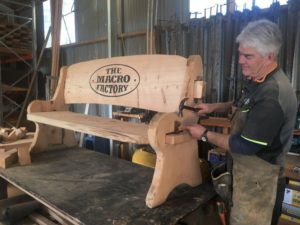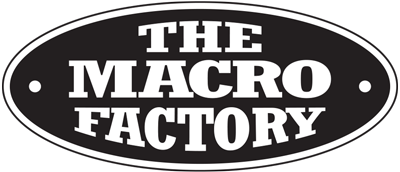About us
 The Macro Factory was established in 2017 with the majority of timber purchased direct from Macrocarpa Supplies saw mill.
The Macro Factory was established in 2017 with the majority of timber purchased direct from Macrocarpa Supplies saw mill.
We are based Lincoln, and supply throughout New Zealand.
We work with home owners, architects, builders, clients on special projects as well as commercial and hospitality projects, for example large five metre tables for outdoor areas, bar leaners, table tops and more!
Check out what our happy customers say!
‘We are delighted with our table and bench seats. The colour, design, and workmanship is excellent. It looks amazing in our outdoor area. Steve was fantastic to work with and really went above and beyond to get the finished product to us. We were so pleased to be able to purchase a product that was handcrafted, made to last and local’McInnes Family Oct 2021
Everyone comments on it, we have passed on your details to many people! This weekend we are having lots more people over so more will probably ask too. We Looooovvvvveee it!Kristina
Hi Steve, We finally picked up table today erected and it’s bloody awesome. Have a great Xmas! Cheers.
Deano
Hi Steve, Thanks for the coffee table, we are very happy with it. So happy in fact that could you please do us a quote to make another one please? Cheers.Mark
We love our table thanks so much! Looks so good on our deck! Thanks heaps!
Kirsty
Wonderful thanks Steve! They look fantastic. Everyone has been so impressed with your quality of work. Cheers and thanks again.
Michelle
Hi Steve, Our table arrived on Friday – it looks fabulous… Just how we hoped it would look so thanks very much! We just need summer to come back so we can actually use it now!
Sally
Many, many thanks for the wonderful furniture!!! We are so very pleased with it. We think they will definitely become heritage pieces for the children. They will certainly see us out.Ian & Melani
Thanks Steve, Bloody good service beyond the call of duty would recommend to anyone very helpful good Canterbury Business. Cheers.Sam
Thanks Steve, I got a top from you and made a great indoors dinning table for my son, am still using it 8 years later and its as good as new.Richard
Why use Macrocarpa?
Macrocarpa has a range of uses including ceiling sarking, exposed beams, flooring, wall panelling, framing, furniture, solid wood bench tops, architraves and skirtings.
It can be used outside for weatherboard, surfeit, facia, pergolas, decking and outdoor furniture. It is not recommended in-ground for construction purposes (including in-ground posts for fencing, decking and pergolas).
Sustainability of Supply
Macrocarpa supplied in New Zealand is grown within New Zealand as an exotic tree.
The timber comes from either a forested plantation source, or farm shelterbelts.
Supplies of good-quality timber are increasing, either milled to specific requirements, or available from specialist suppliers as finished products (for example, mouldings and flooring profiles).
In the early 1950s, it was estimated that there were about 360 ha of pure macrocarpa plantations in State forests, 255 in mixtures and another 405 ha in private plantations.
Well-managed plantations of cypress have since been established. The National Exotic Forest Description (NEFD) (Ministry of Agriculture and Forestry, 2006) estimated that, in 2006, there were about 7,000 ha of standing cypress plantations.
Cypress timbers currently make up the third most commonly used exotic timber species in New Zealand, with approximately 20,000 m3 cut per year.
Therefore, for small landowners, the species represents a viable economic alternative to radiata pine for woodlots.
The increase in market demand for cypresses offers farmers both a low-cost way to reduce negative impacts of farming on the environment, and a lower-impact land-use option than radiata pine.
In New Zealand, the timber is graded into Clears, Dressing and Utility grades. Supply of timber milled to larger sizes is limited in certain parts of the country, and sizes larger than 150 x 50 mm can be difficult to source.
Botanical name: Cupressus macrocarpa
Other common names: Macrocarpa, Monterey Cypress
Strength: Macrocarpa is a low-to medium-density softwood that looks and works like kauri.
Durability: Both the heartwood and sapwood of macrocarpa are naturally borer resistant (Anobium) for interior housing purposes. The heartwood is moderately durable for above-ground purposes, but the sapwood is non-durable. The timber cannot be pressure treated with copper, chromium and arsenic (CCA), but sapwood can be boron diffusion treated to resist insects (but not decay).
Finishes: Macrocarpa, when dry, will accept a variety of paints, oils, two pot resins and varnishes.
Working properties: Macrocarpa has a fine grain and machines and sands well to give a high-quality finish.
Appearance: The heartwood is golden brown and has a speckled lustre, which is rare in timber.
Macrocarpa is a low- to medium-density softwood that looks and works like kauri.
Description
The heartwood is golden brown and has a speckled lustre, which is rare in timber.
The sapwood is very light brown and typically occupies about five growth rings.
Freshly cut timber has a fragrant spicy odour, which is typical of cypresses. It is a very stable wood, is easily sawn and has relatively low surface hardness, with good working and finishing characteristics and relatively uniform wood properties.
This allows even small diameter logs of 15–20 cm, and young ‘teenage’ trees, to be sawn to produce quality timber.
Durability
Macrocarpa heartwood is naturally durable for above-ground purposes, but sapwood requires treatment.
The timber cannot be pressure treated with copper, chromium and arsenic (CCA), but sapwood can be boron diffusion treated to resist insects (but not decay).
For this reason, if macrocarpa is to be used for outdoor purposes, heartwood should be specified and supplied.
Above ground, the heartwood timber should be sound for 20 to 30 years, and if exposed to the weather, but protected from direct sun and rain, will last 40 to 60 years.
A 50 x 50 mm stake will last 10 to 15 years in the ground.
Both the heartwood and sapwood of macrocarpa are naturally borer resistant (Anobium) when used for interior housing purposes.
Macrocarpa can be used for interior uses: ceiling sarking; exposed beams; flooring; wall panelling; framing; furniture; solid wood bench tops; architraves; skirtings.
It can be used outside for: weatherboard, surfeit, facia, pergolas, decking and outdoor furniture.
It is not recommended in-ground for construction purposes (including in-ground posts for fencing, decking and pergolas)
